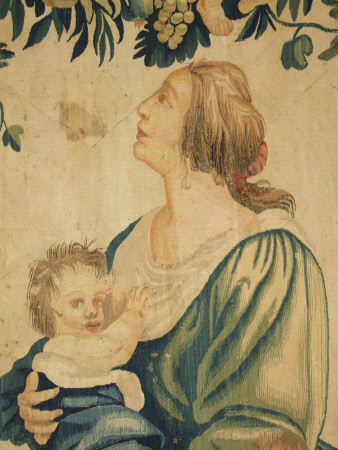Charity
Flemish
Category
Tapestries
Date
circa 1640 - circa 1660
Materials
Tapestry, wool and silk, 5½ warps per cm
Measurements
2.73 m (H); 1.75 m (W)
Place of origin
Belgium
Order this imageCollection
Owletts, Kent
NT 1411228
Summary
Tapestry, wool and silk, 5 ½ warps per cm, Charity, Flemish, c. 1640-1660. In the centre of the tapestry a seated female figure suckles a child. A second child stands by her knee holding aloft a flaming lamp, to the left a third child holds up a heart, and above a fourth child sits on a swag of fruit. At the sides and bottom of the tapestry there are scrolling architectural decorations. A number of large patches have been applied to the tapestry around the edges.
Full description
The central female figure is an allegorical representation of Charity, the most important of the three Cardinal Virtues. The attributes of a flaming torch and a heart were associated with Charity from the middle ages onwards. In the sixteenth and seventeenth centuries Charity was represented in the Catholic church in the guise of the 'Virgo lactans' (breastfeeding Virgin), the Virgin Mary dressed in red and blue, surrounded by three children and suckling one of them, as in the present tapestry (Hall 1996, p. 64). The tapestry probably comes from a larger series with a religious or moral subject. The monumental figure of Charity, the playful infants and the architectural surround are all reminiscent of the style of Peter Paul Rubens, especially his tapestry series of the 'Triumph of the Eucharist' designed and woven for Isabella Clara Eugenia Regent of the Netherlands in 1625-7. The 'Eucharist' series included a scene of 'The Triumph of Divine Love' where a figure of Charity is surrounded by naked children, one holding a heart and a flaming torch (Scribner 1982, pp. 65-67, 74-77). The tapestry was identified by H C Marillier in the 1930s as a product of the Medici workshops in Florence (note on old inventory card), and more recently it has been described as a Mortlake tapestry. It is however stylistically closest to Flemish tapestries of the mid seventeenth century. (Helen Wyld, 2012)
Provenance
Bought by Mrs Keightley (Kensington Antique dealer) on behalf of Sir Herbert Baker (1862-1946) for £115 at Christies, July 1931. Given to the National Trust in 1938 with Owletts and its contents by Sir Herbert Baker.
Credit line
Owletts, the Sir Herbert Baker Collection (The National Trust)
Makers and roles
Flemish, workshop
References
Hall, 1996: James Hall, Dictionary of Subjects and Symbols in Art, rev. edn. Cambridge 1996 Scribner, 1982: Charles III Scribner, The Triumph of the Eucharist, Tapestries Designed by Rubens, Ann Arbor, Michigan 1982

